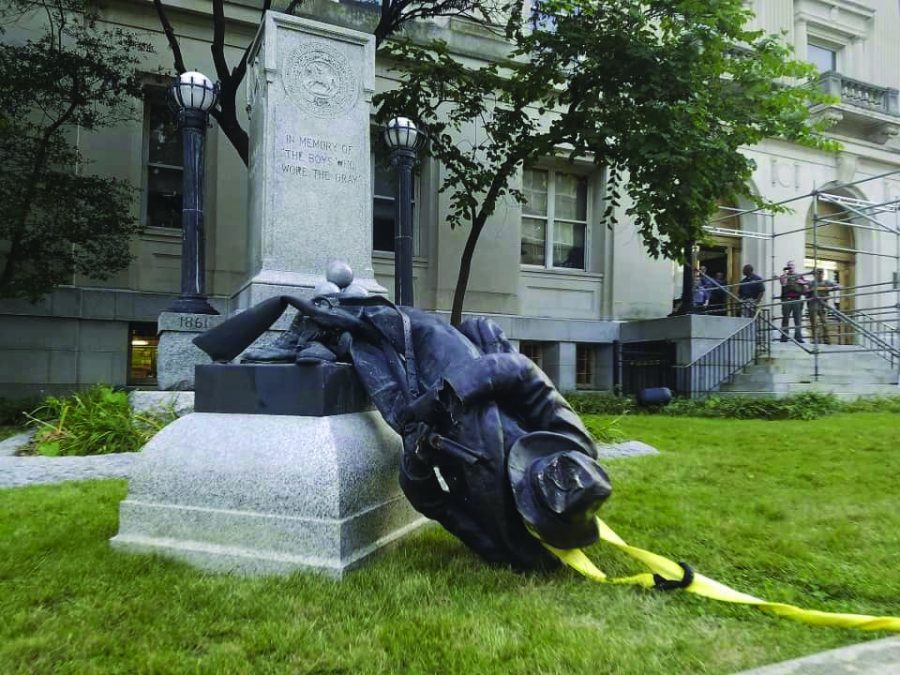Confederate Statues Spark Debate On How To Handle History
With many protests happening currently, many confederate statues have fallen, including this one.
January 6, 2021
As America’s political divide strengthens, compromise has all but vanished in the minds of our most prominent politicians. Issues such as what to do with Confederate monuments are put on the backburner due to the inability of our politicians to figure out a solution.
Whether people deny the racism we still have in our country or not, there is no denying that every single State has a history that should be shared to prevent new generations from developing a prejudiced mindset.
In our community alone, we are surrounded by systemic racism and a history of minority abuse. Media sources such as Peimag (https://www.peimag.com/top-10-most-racist-states-in-america/) have reported that Florida is one of the ten most racist states in America based on racist incidents and online trends. The Jupiter Lighthouse was built in the 19th century, the building of which plowed through Native American homelands and reservations. The Benjamin School was founded as a private institution in the South just as public schools were being desegregated. Florida, as of 2016, has 8 active chapters of the KKK.
Since Florida was part of the Confederacy, none of these facts are shocking. Florida has many racist monuments and Confederate tributes. One example is the mural on Baker County Courthouse. The mural depictsKKK members majestically riding their horses into the sunset. Another is the Jefferson Davis monument in Pensacola, which glorifies the man who led the Confederacy in its quest to secede from the Union for states’ rights. Unfortunately, according to an article titled “History of the American Civil War” from history.com, it’s widely recognized that the Civil War was fought over the right to own slaves.
Although it is an ongoing debate, the issue of what is to be done with these monuments and memorials has been recently reenergized due to the thousands of people who participated in racial injusticeprotests this summer following the death of George Floyd.
While some think we should keep them up as a symbol of our history and southern pride, others, believe this does not properly condemn racism, opting for the tear-down-the-statues argument. Rather than choosing one extreme or the other, there is a much more simple solution.
The best way to deal with racism in our country is through education. A study in Fox Business (https://www.foxbusiness.com/lifestyle/most-least-educated-states-america-2020) found that areas south of Virginia and east of Texas are the least educated region in America, measured by educational benchmarks such as degrees and the quality of education. The list coincides with Peimag’s Most Racist States article nearly perfectly. We can take down the Confederate statues and put them in museums and other learning institutions without having, as President Donald Trump put it, “our history and culture being ripped apart with the removal of our beautiful statues.”
If we were to take down the glorified status of racist Confederate leaders and put them in a setting that explained how these leaders were awful people, we would be pleasing both sides by taking down the statues and also not erasing our history. If people want our country’s history to remember Jefferson Davis as a symbol of southern pride, then we should not only be remembering him as a powerful figure in the Civil War but also as someone who supported slavery.
There should be similar energy towards the KKK mural. It does not educate people to tear down a part of history, but people should be informed about what that mural stands for.
Both public and private schools should be exposed to our history, as Spanish American philosopher George Santayana said regarding the notion of progress, “Those who cannot remember the past are condemned to repeat it” By subjecting impressionable youth to the horrors of racism from an educational viewpoint in the context of history, we can utilize these confederate monuments as a fundamental tool of progress.



